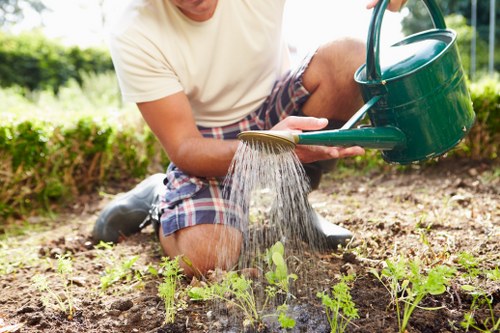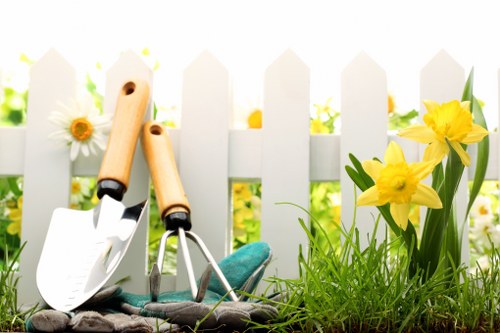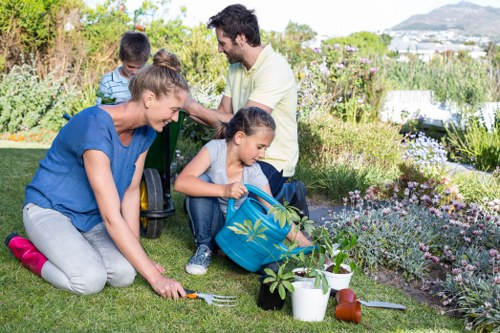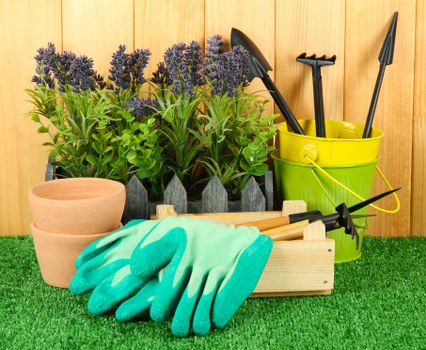Comprehensive Guide to Garden Maintenance in Hainault
Introduction to Garden Maintenance

Maintaining a beautiful garden in Hainault requires a blend of passion, knowledge, and consistent effort. Whether you are a seasoned gardener or just starting out, understanding the unique aspects of garden care in this region can help you achieve a thriving outdoor space.
Hainault's climate and soil conditions play a significant role in determining the best gardening practices. By tailoring your maintenance routine to these local factors, you can ensure your garden remains vibrant throughout the year.
In this article, we will explore essential garden maintenance tips, seasonal tasks, and expert advice to help you keep your Hainault garden in top shape.
Seasonal Garden Maintenance

Spring Maintenance
Spring is a crucial time for garden maintenance in Hainault. As the weather warms up, it’s essential to prepare your garden for the growing season.
Start by clearing out winter debris, such as fallen leaves and dead plants. This not only improves the garden's appearance but also prevents diseases from taking hold.
Next, focus on soil preparation. Incorporate organic matter like compost to enhance soil fertility and structure, providing a healthy foundation for your plants.
- Pruning dead branches
- Applying fertilizer
- Planting new flowers and shrubs
Regular Garden Upkeep

Weeding and Mulching
Regular weeding is essential to prevent unwanted plants from competing with your garden's desired species. Consistent removal of weeds helps maintain the garden’s health and aesthetic appeal.
Mulching is another critical maintenance task. Applying a layer of mulch around your plants helps retain moisture, suppress weeds, and regulate soil temperature.
Choose the right mulch for your garden, such as bark, straw, or compost, to maximize its benefits and complement your garden’s design.
Watering and Irrigation

Efficient Watering Practices
Proper watering is vital for garden health. In Hainault, where rainfall can be variable, it's important to establish an efficient watering system.
Consider installing an automated irrigation system to ensure consistent watering. Drip irrigation is particularly effective, delivering water directly to the plant roots and minimizing evaporation.
Additionally, water your garden during the early morning to reduce water loss and prevent fungal diseases caused by evening moisture.
- Install rain barrels to collect and reuse rainwater
- Use moisture sensors to monitor soil hydration
- Schedule regular watering times
Pest and Disease Management

Keeping Your Garden Healthy
Maintaining a pest-free garden is essential for the health of your plants. Regular inspections can help identify and address issues before they become severe.
Use integrated pest management (IPM) techniques, which combine biological, cultural, and chemical methods to control pests effectively and sustainably.
Encourage beneficial insects, such as ladybugs and lacewings, which naturally reduce pest populations. Additionally, rotate crops annually to disrupt pest life cycles.
- Apply organic pesticides when necessary
- Maintain plant diversity to prevent pest outbreaks
- Remove and dispose of infected plants promptly
Pruning and Trimming
Enhancing Plant Health and Appearance
Regular pruning and trimming are vital for maintaining the shape and health of your plants. Properly pruned plants are more resistant to diseases and pests, and they promote better airflow.
Focus on removing dead or diseased branches, as well as any growth that disrupts the plant's natural form. Use sharp, clean tools to make precise cuts, minimizing damage to the plants.
Timing is key when it comes to pruning. Different plants have specific pruning seasons, so familiarize yourself with the needs of each species in your garden.
- Prune flowering shrubs after blooms fade
- Trim hedges in early spring
- Cut back perennials in late autumn
Soil Health and Fertilization
Building Fertile Ground
Healthy soil is the foundation of a thriving garden. Regular soil testing can help you determine nutrient deficiencies and pH imbalances, allowing you to adjust your fertilization strategy accordingly.
Incorporate organic fertilizers, such as compost or well-rotted manure, to enhance soil fertility naturally. Avoid over-fertilizing, which can harm plants and leach harmful chemicals into the environment.
Implementing cover crops during off-seasons can also improve soil structure and prevent erosion, maintaining long-term garden productivity.
- Test soil pH annually
- Add lime or sulfur to adjust pH levels
- Use balanced fertilizers for optimal growth
Plant Selection and Care
Choosing the Right Plants for Hainault
Selecting plants that are well-suited to Hainault's climate and soil conditions is crucial for successful garden maintenance. Opt for native species that are adapted to local environmental factors, reducing the need for excessive care.
Incorporate a mix of perennial and annual plants to ensure year-round color and variety. Consider the specific sunlight, water, and soil requirements of each plant to create a balanced and sustainable garden ecosystem.
Regularly monitor plant health and adjust care routines as needed to address any signs of stress or disease promptly.
- Choose drought-resistant plants for water conservation
- Incorporate flowering plants to attract pollinators
- Use companion planting to enhance growth and deter pests
Lawn Care
Maintaining a Green and Healthy Lawn
A well-maintained lawn adds beauty and value to your Hainault garden. Regular mowing, watering, and fertilizing are essential for keeping your grass healthy and lush.
Ensure your lawn receives adequate sunlight and is free from weeds that can compete for nutrients and water. Aerate the soil annually to promote healthy root growth and improve air circulation.
Overseeding can help fill in bare spots and maintain a dense, vibrant lawn. Choose grass varieties that are resilient to local pests and diseases for optimal results.
- Mow at the recommended height for your grass type
- Water deeply but infrequently
- Apply a balanced lawn fertilizer in spring and autumn
Hardscaping and Garden Structures
Enhancing Garden Functionality and Aesthetics
Incorporating hardscaping elements, such as pathways, patios, and garden sheds, can enhance both the functionality and visual appeal of your garden. These structures provide practical benefits while adding character and style to your outdoor space.
Regular maintenance of hardscaping features is essential to prevent wear and tear. Clean surfaces, repair any damages, and ensure that structures remain safe and attractive.
Integrate garden lighting to extend the usability of your garden into the evening hours and highlight key features.
- Install durable materials that withstand local weather conditions
- Design pathways for easy navigation
- Incorporate seating areas for relaxation and entertainment
Garden Tools and Equipment
Essential Tools for Effective Maintenance
Having the right tools is fundamental to efficient garden maintenance. Invest in high-quality equipment that suits your gardening needs and makes tasks easier and more enjoyable.
Regularly inspect and maintain your tools to ensure they remain in good working condition. Clean blades, sharpen edges, and store equipment properly to extend their lifespan.
Consider using eco-friendly tools, such as manual pruners and composters, to reduce your garden's environmental impact.
- Essential tools include spades, rakes, and pruning shears
- Store tools in a dry, organized space
- Upgrade to ergonomic designs for better comfort
Composting and Waste Management
Sustainable Practices for Garden Health
Composting is a sustainable practice that recycles organic waste into valuable soil amendments. By composting kitchen scraps and garden waste, you can enrich your garden's soil naturally.
Start a compost bin in your garden, ensuring it is well-ventilated and receives adequate moisture. Turn the compost regularly to speed up the decomposition process and prevent unpleasant odors.
Use the finished compost to mulch garden beds or as a fertilizer, reducing the need for chemical inputs and promoting environmental sustainability.
- Collect organic waste from kitchen and garden
- Maintain a balanced carbon-to-nitrogen ratio
- Use compost in seasonal garden preparations
Winter Garden Care
Preparing Your Garden for the Colder Months
Winter poses unique challenges for garden maintenance in Hainault. Proper preparation can protect your plants and ensure a healthy start in the spring.
Start by cleaning up fallen leaves and debris to prevent fungal diseases and pest infestations. Prune perennials and shrubs to encourage strong growth in the coming year.
Protect sensitive plants by covering them with mulch or frost cloth. Additionally, disconnect and store garden hoses and tools to prevent damage from freezing temperatures.
- Insulate plant beds with mulch or blankets
- Store delicate plants indoors if necessary
- Plan and design garden layouts for next year
Professional Garden Maintenance Services
When to Seek Expert Help
While many garden maintenance tasks can be managed independently, there are times when professional assistance is beneficial. Experts can provide specialized knowledge and advanced techniques to enhance your garden's health and appearance.
Consider hiring a professional for tasks such as major pruning, landscaping projects, and pest control. They can offer tailored solutions that align with your garden's specific needs and your personal preferences.
Contacting a local garden maintenance service in Hainault ensures you receive support that understands the area's unique gardening conditions, leading to more effective and sustainable outcomes.
- Schedule regular maintenance visits
- Consult experts for landscape design
- Utilize professional pest and disease management
Eco-Friendly Gardening Practices
Sustainable Approaches for a Greener Garden
Embracing eco-friendly gardening practices not only benefits the environment but also promotes a healthier and more resilient garden. Implementing sustainable methods can reduce your garden's carbon footprint and enhance its natural beauty.
Use organic fertilizers and pest control methods to minimize chemical usage. Planting native species supports local biodiversity and reduces the need for excessive watering and maintenance.
Incorporate water conservation techniques, such as rainwater harvesting and drip irrigation, to ensure efficient use of resources and maintain garden vitality.
- Adopt renewable energy sources for garden lighting
- Utilize recycled materials for garden structures
- Promote biodiversity with diverse plant selections
Conclusion
Achieving a Thriving Garden in Hainault
Effective garden maintenance in Hainault involves a combination of regular care, seasonal adjustments, and sustainable practices. By understanding the local climate and soil conditions, selecting appropriate plants, and implementing efficient maintenance routines, you can create a beautiful and resilient garden.
Whether you choose to undertake garden maintenance yourself or seek professional assistance, the key is consistency and attention to detail. A well-maintained garden not only enhances your outdoor living space but also contributes positively to the environment.
Ready to transform your garden? Contact us today and let our experts help you achieve the garden of your dreams in Hainault.